In construction projects, the term “schedule” doesn’t only refer to the project timeline. There are many types of schedules used to manage different aspects of the job. These include the resource schedule, equipment schedule and the material schedule, which ensures materials such as concrete, rebar, piping and insulation arrive on time.
What Is a Material Schedule In Construction?
A material schedule in construction is a detailed document listing all building materials required for a project. It includes descriptions, quantities, specifications, delivery dates and suppliers. This schedule ensures teams know exactly what’s needed, when it’s needed and helps avoid delays due to missing or late materials.
A material schedule in construction outlines the types, quantities, delivery dates, and lead times for all building materials required throughout the project. It directly impacts the Gantt chart because material availability influences when tasks can start or finish—especially for activities like framing, concrete pours or mechanical installations. Delays in material procurement or delivery can disrupt task dependencies, pushing back milestones and creating bottlenecks. Accurately integrating the material schedule into the Gantt chart helps ensure tasks are planned realistically, reducing downtime and preventing costly rescheduling.
ProjectManager has award-winning Gantt charts that make managing this process easier by allowing teams to link tasks to material delivery dates, set all four types of task dependencies and adjust schedules with drag-and-drop functionality in real time. If a material delay occurs, the Gantt chart automatically reflects how that affects downstream tasks, keeping the entire project plan accurate and up to date. Once a baseline is set, the Gantt chart also integrates with dashboards and reports, so any impact on scheduling or costs from material changes is visible instantly, enabling proactive decisions that keep the construction project moving forward efficiently. Get started with ProjectManager today for free.
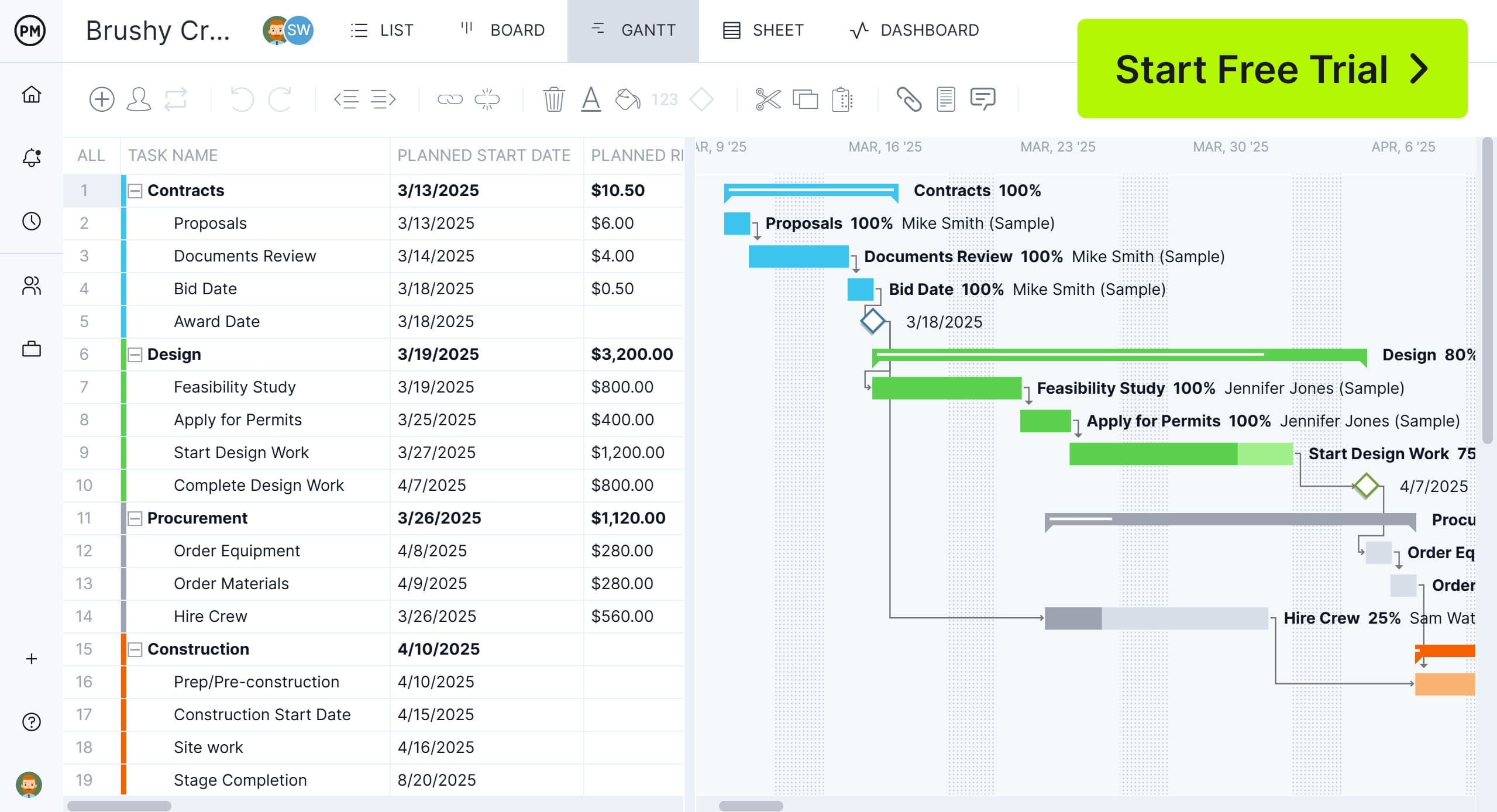
Benefits of Using a Material Schedule
Using a material schedule helps organize procurement, reduces the risk of delays and prevents cost overruns. It also supports better coordination among teams by clearly communicating what materials are required and when they must be available on-site.
Facilitates Cost Estimation and Project Budgeting
A well-structured material schedule provides detailed information about the type, quantity and specification of each material needed for a construction project. With this level of clarity, estimators can assign accurate unit costs and calculate total material expenses. This data becomes a critical input when building the project budget. It ensures that material-related costs are accounted for upfront, reducing the risk of underestimating expenses. In turn, this supports better financial planning, cost control and allows teams to align procurement with available funding from the start.
Prevents Project Delays
A material schedule helps teams stay ahead by identifying what materials are needed and when. With lead times and delivery sequences clearly defined, procurement teams can place orders early and coordinate with suppliers effectively. This prevents last-minute scrambles, backorders and shipping delays, keeping the project on schedule.
Better Inventory Management
A clear material schedule gives construction teams a full view of what materials are needed, when they’re needed and in what quantities. This visibility helps track what’s already in stock, what must be ordered and what’s arriving soon. It reduces the risk of over-ordering or running out of critical materials on-site. With accurate data, teams can maintain optimal inventory levels, avoid waste and support smooth on-site operations throughout each project phase.
Related: 7 Free Inventory Templates
Streamlines Procurement Planning
With a material schedule in place, procurement teams can plan purchases based on accurate quantities, lead times and delivery timelines. This improves coordination with vendors, supports bulk ordering where appropriate and aligns deliveries with the construction sequence. It also helps identify long-lead items early and flag any supply chain risks. By organizing procurement in advance, teams reduce uncertainty, negotiate better pricing and ensure materials are acquired efficiently to keep the project moving forward as planned.
What Should Be Included in a Material Schedule?
To be effective, a material schedule must include more than just a list of building supplies. It should provide complete context about the project, clearly identify materials and support communication across teams responsible for procurement, delivery and use on-site.
1. General Project Information
Including basic project details in a material schedule ensures clarity and traceability. It allows teams to quickly confirm the schedule’s relevance, track changes over time and know who created and approved the document. This information adds accountability and helps keep documentation aligned with the overall construction workflow.
Here are some elements that should be included in this section:
- Project name and location
- Schedule ID/reference number
- Date of issue and revisions
- Prepared by and approved by
2. Itemized List of Materials
An itemized list makes the material schedule functional by breaking down each required material in a clear, structured way. It supports procurement, inventory and delivery coordination by specifying how each material should be identified, measured and described, which ultimately helps avoid confusion or ordering mistakes.
Here are some of the characteristics that should be described for each itemized material:
- Item number or code (for easy reference)
- Material name/type (e.g., concrete, rebar, brick)
- Dimensions/size (e.g., 2” x 4” lumber, 20mm diameter rebar)
3. Material Specifications and Grades
Including material specifications and grades ensures that the materials delivered meet the required standards for quality and performance. This is essential for structural integrity, safety and compliance with design documents. Clear specifications help suppliers deliver the correct materials and minimize the risk of project delays due to mismatches or rework.

4. Unit of Measure and Required Quantities
Defining the unit of measure for each item ensures consistency and clarity in ordering and tracking materials. It eliminates confusion over how materials are quantified and priced. Including the required quantity for each item helps accurately forecast needs, supports procurement and prevents shortages and unnecessary overstocking on-site.
5. Estimated Costs of Materials
Estimated costs for each material are usually based on multiplying the unit price by the required quantity, with both values linked to a specific unit of measurement such as per cubic yard, per foot or ton. This calculation supports accurate budgeting and cost control. Including costs in the schedule also helps compare supplier pricing, prioritize purchases and flag high-cost items that need special attention or alternative sourcing strategies.
6. Wastage Allowance
Wastage allowance refers to the additional quantity of materials included in a material schedule to account for losses that may occur during handling, cutting, transport or installation. Including this allowance helps ensure that the project won’t be delayed due to minor shortages.
It reflects realistic consumption rates on-site and supports better cost forecasting. Without it, teams risk underordering materials, which can result in schedule disruptions, emergency purchases and increased expenses. A well-estimated wastage allowance improves efficiency and reduces the chance of unplanned interruptions.
Related: 18 Best Construction Scheduling Software of 2025
7. Preferred Supplier or Manufacturer
Listing a preferred supplier or manufacturer ensures consistency in material quality and compliance with project requirements. It simplifies procurement by giving purchasing teams clear direction and reducing time spent researching alternatives. It can also help maintain compatibility with other project components or meet client specifications.
8. Material Delivery Information
Including delivery information in a material schedule ensures that materials arrive at the right place, on the right date and in the correct sequence. Details like required delivery dates, drop-off locations and phase-specific timing help teams coordinate logistics. This prevents site congestion, minimizes storage needs and reduces the risk of delays.
Some of the basic elements to include in this section are:
- Required delivery date: when the material must arrive on site
- Delivery sequence or phase: if materials are to be delivered in batches
- Delivery location: exact drop-off point or zone on-site
- Supplier committed delivery date: helps track delays or changes
9. Intended Use and Location
Specifying the intended use and location of each material helps ensure it’s delivered and installed where it’s needed. This improves on-site coordination and avoids costly mistakes, like using the wrong material in a structural application or delivering materials to the wrong floor. It also helps align deliveries with work sequences, improves communication among teams and supports efficient use of labor and equipment on-site, especially for large or multi-phase projects with complex logistics and layout requirements.
Related: 20 Free Excel Construction Templates
10. Special Notes
Special notes provide critical context that may affect how materials are ordered, delivered or used. This includes special handling or storage instructions, testing or certification requirements and any approved material substitutions.
Additional examples include lead time considerations, fire rating specifications, finish requirements or temperature sensitivity. Including this type of information prevents misunderstandings, ensures compliance with project specifications and improves communication among suppliers, procurement teams and site supervisors. It also supports smoother inspections and reduces the risk of rework due to overlooked material conditions.
Material Schedule Template
To help you create your own material schedule, we’ve designed a free Excel template tailored for construction projects. It includes fields for general project info, itemized materials, costs, suppliers and delivery details. Whether you’re building a home or managing a larger project, this spreadsheet makes it easy to organize and track everything you need.
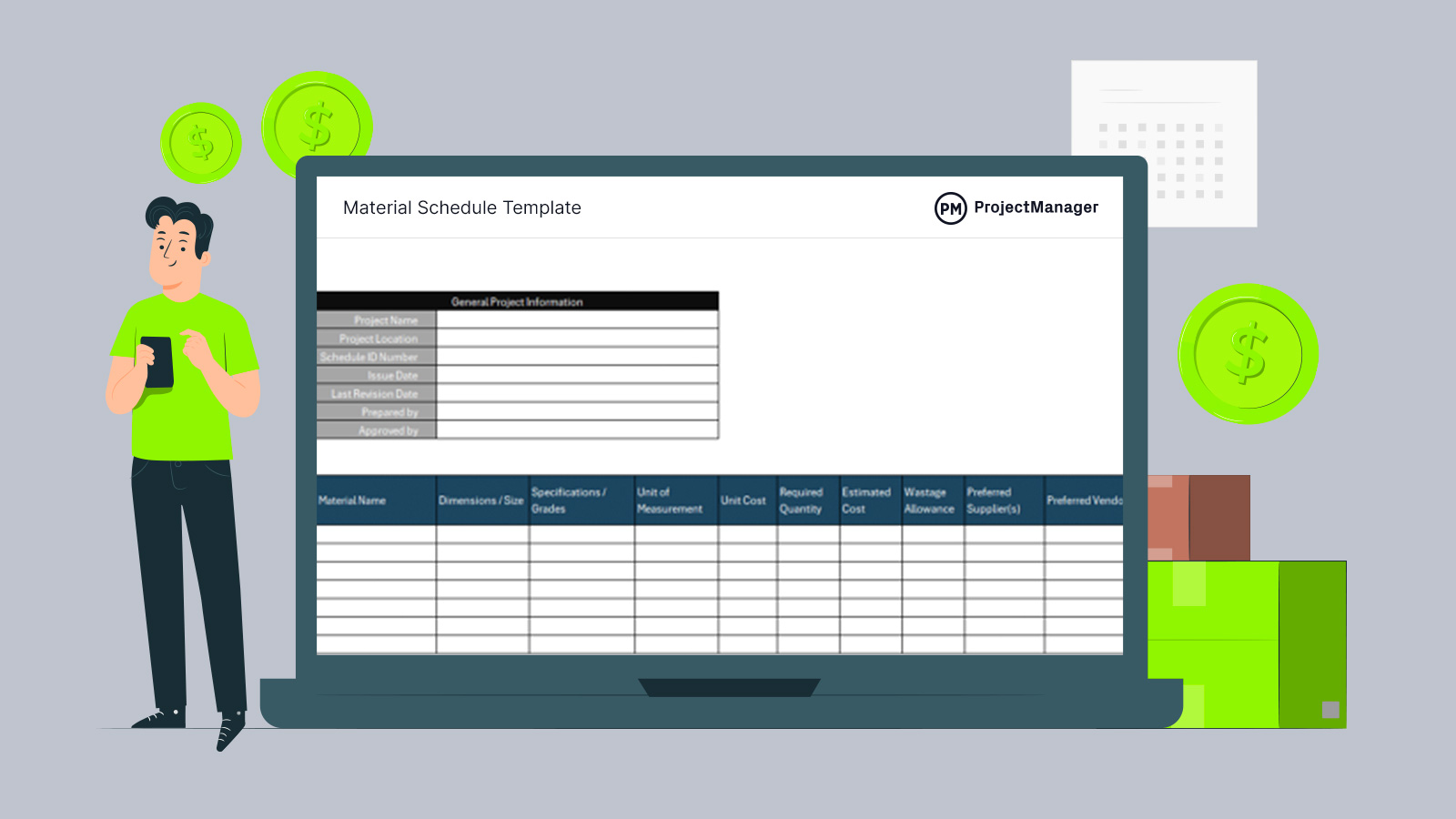
Get your free
Material Schedule Template
Use this free Material Schedule Template for Excel to manage your projects better.
Material Schedule Example
Here’s a sample material schedule for a small residential construction project—a single-family house. The schedule outlines core materials such as concrete, lumber, rebar and drywall, along with their specifications, quantities, unit costs and delivery details.
By planning this, the contractor can streamline procurement, track supplier commitments and ensure materials arrive at the correct location just when they’re needed. This reduces costly delays and supports smoother site coordination, especially in early phases like foundation pouring and framing. This is how this material schedule example would look.

Free Related Construction Project Management Templates
For those not ready to upgrade to project management software, we have over 100 free project management templates that can help with the construction management process. Here are just a few that can help with scheduling a construction project.
Construction Budget Template
Download this free construction budget template to estimate, organize and track all project-related costs, including labor, materials, equipment, permits, subcontractors and contingencies. It provides a structured way to break down expenses by phase or category, allowing project managers to compare projected costs against actual spending in real time. By offering clear financial visibility, a construction budget template helps control costs, prevent overruns and ensure the project stays within its financial limits throughout the build.
Inventory Template
Use this free inventory template to track materials, tools, equipment and supplies on a construction site. It includes item names, quantities, locations, usage status and reorder levels. In construction, it helps ensure that the right materials are available when needed, reducing delays caused by shortages or misplaced items. By maintaining accurate records, an inventory template supports better resource planning, minimizes waste and improves budgeting, helping keep the project running efficiently and on schedule.
Construction Scope of Work Template
This free construction scope of work template is a pre-structured document used to outline the essential details of a construction project, including the work to be performed, materials required, timelines, responsibilities and project deliverables. This template helps standardize the planning process, ensuring all parties—owners, contractors and subcontractors—are aligned on expectations before work begins. By clearly defining each aspect of the project, the template reduces confusion, limits scope creep, and supports smoother communication and execution throughout the construction lifecycle.
ProjectManager Is Advanced Construction Scheduling Software
Construction projects can do better than using static templates, which require manual updates and are poor collaboration tools. ProjectManager, on the other hand, offers a dynamic, real-time platform that updates instantly as work progresses, eliminating the delays and manual errors often associated with spreadsheets. Our real-time dashboards provide immediate visibility into task progress, resource use and schedule health, allowing managers to spot and address issues before they escalate.
Customizable reports deliver in-depth insights into project performance, helping teams analyze schedule variance, productivity and budget alignment. Meanwhile, secure timesheets ensure accurate, timely tracking of labor hours, feeding directly into schedules and cost reports. These features give construction teams the live data and automation they need to make informed decisions quickly and keep projects on time and under control, far beyond what a template can offer.
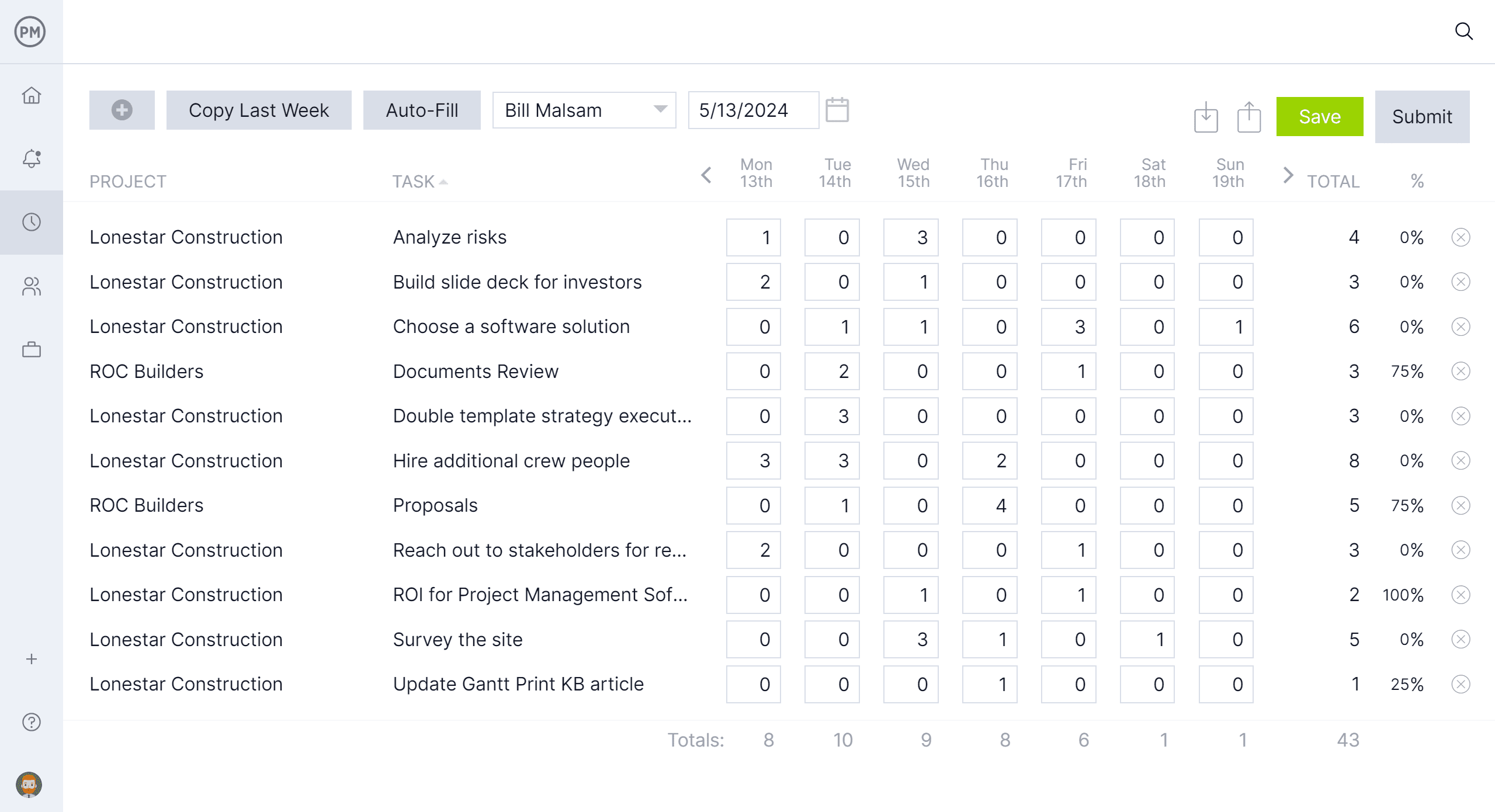
Execute Tasks With Multiple Construction Scheduling Views
ProjectManager offers multiple powerful construction scheduling tools—including Gantt charts, calendar views, kanban boards, and sheet views—but the task list stands out as a practical, boots-on-the-ground tool for daily construction management. The task list provides a clear, organized view of all assignments, showing deadlines, priorities, statuses and assignees in a format that’s easy to scan and act on.
It’s ideal for foremen, supervisors, and crew members who need a straightforward way to track what needs to be done each day. Because it syncs in real time with other views like the Gantt chart or calendar, any updates made in the field instantly reflect across the entire project schedule, keeping everyone—from the site office to the executive team—aligned and on track.
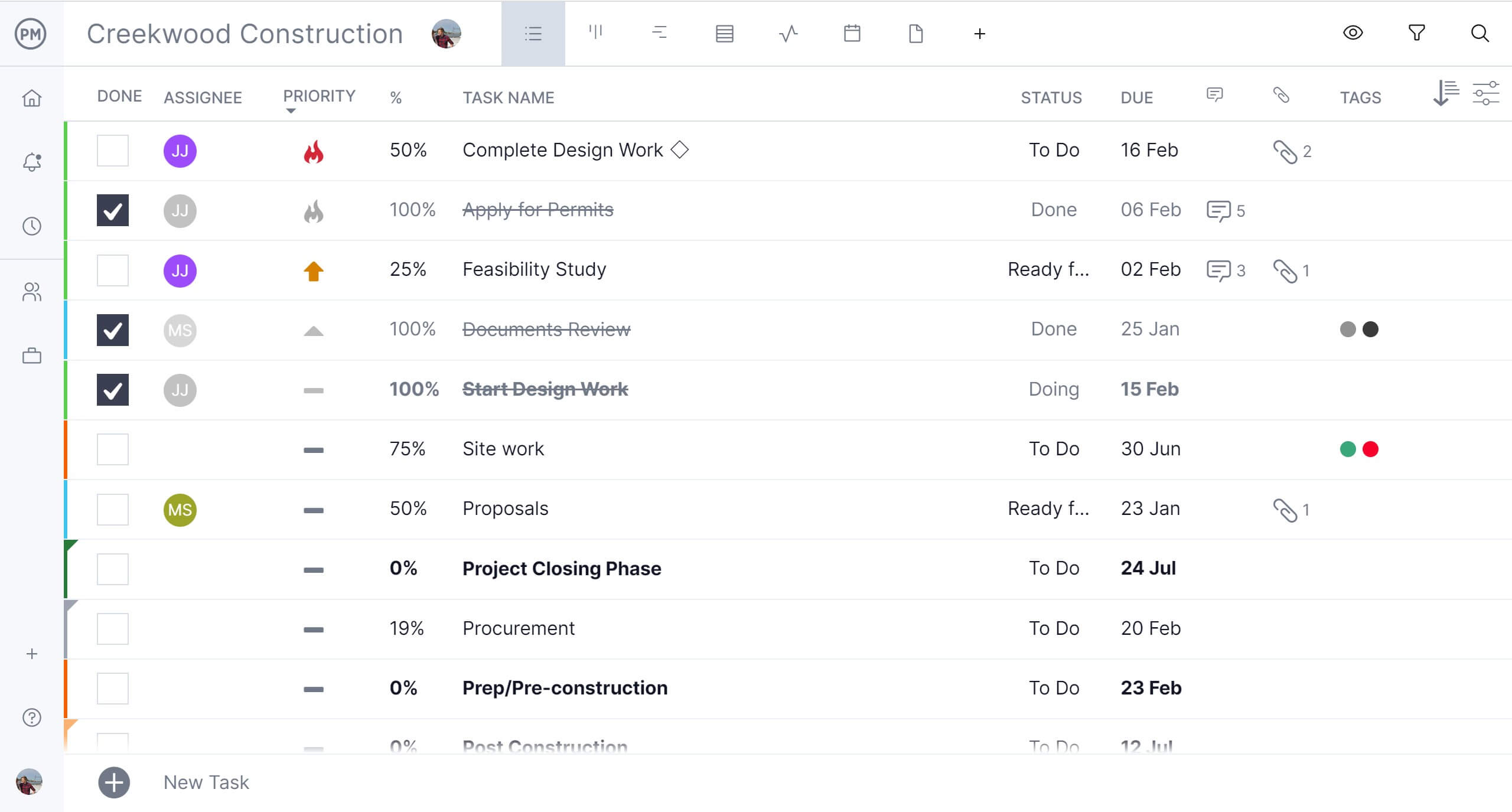
Schedule Effectively With Robust Resource Management Features
Use our availability feature to ensure that tasks are only assigned when workers or crews are on-site or available, reducing scheduling conflicts and idle time. The team page offers a centralized view of each team member’s roles, current assignments and working capacity, making it easy to plan labor based on skill sets and real-time workload.
The color-coded workload chart visually highlights over- or under-utilized team members, allowing managers to balance assignments quickly and avoid burnout or resource gaps. Together, these tools help construction teams schedule smarter, deploy labor efficiently and keep projects running smoothly from planning through completion.
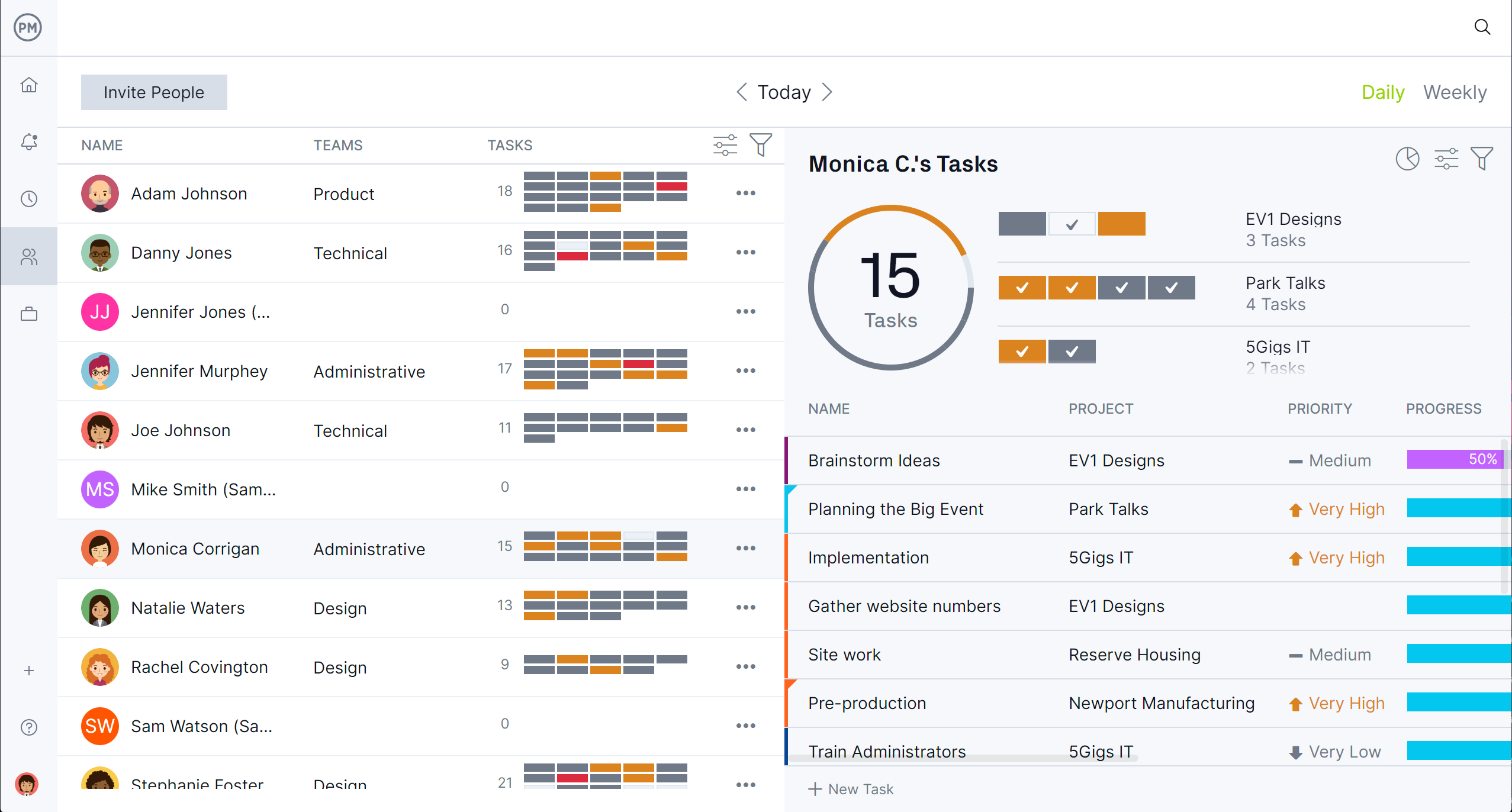
Related Construction Project Management Content
A material schedule is part of the larger construction project management process. For readers who want to learn more about how to manage construction projects, check out the links below. They lead to recently published articles on process, document management, reporting and more.
- Construction Management: Process, Key Areas and Roles
- 20 Free Excel Construction Templates
- Construction Phases: Documentation, Templates & Steps
- 32 Construction Documents (Templates Included)
- Construction Reporting: Types of Construction Reports
- 14 Types of Construction Contracts: Pros, Cons & Best Practices
ProjectManager is online project and portfolio management software that connects teams whether they’re in the office or out in the field. They can share files, comment at the task level and stay up to date with email and in-app notifications. Join teams at Avis, Nestle and Siemens who are using our software to deliver successful projects. Get started with ProjectManager today for free.

